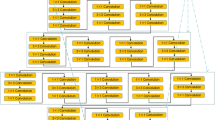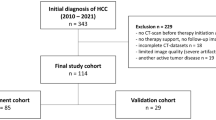Abstract
The goal of this study was to evaluate the performance of a convolutional neural network (CNN) with preoperative MRI and clinical factors in predicting the treatment response of unresectable hepatocellular carcinoma (HCC) patients receiving hepatic arterial infusion chemotherapy (HAIC). A total of 191 patients with unresectable HCC who underwent HAIC in our hospital between May 2019 and March 2022 were retrospectively recruited. We selected InceptionV4 from three representative CNN models, AlexNet, ResNet, and InceptionV4, according to the cross-entropy loss (CEL). We subsequently developed InceptionV4 to fuse the information from qualified pretreatment MRI data and patient clinical factors. Radiomic information was evaluated based on several constant sequences, including enhanced T1-weighted sequences (with arterial, portal, and delayed phases), T2 FSE sequences, and dual-echo sequences. The performance of InceptionV4 was cross-validated in the training cohort (n = 127) and internally validated in an independent cohort (n = 64), with comparisons against single important clinical factors and radiologists in terms of receiver operating characteristic (ROC) curves. Class activation mapping was used to visualize the InceptionV4 model. The InceptionV4 model achieved an AUC of 0.871 (95% confidence interval [CI] 0.761–0.981) in the cross-validation cohort and an AUC of 0.826 (95% CI 0.682–0.970) in the internal validation cohort; these two models performed better than did the other methods (AUC ranges 0.783–0.873 and 0.708–0.806 for cross- and internal validations, respectively; P < 0.01). The present InceptionV4 model, which integrates radiomic information and clinical factors, helps predict the treatment response of unresectable HCC patients receiving HAIC treatment.





Similar content being viewed by others
Availability of Data and Materials
The data used in the article are available with reasonable request from the corresponding author.
Abbreviations
- HCC:
-
Hepatocellular carcinoma
- TACE:
-
Transarterial chemoembolization
- HAIC:
-
Hepatic arterial infusion of oxaliplatin
- CNNs:
-
Convolutional neural networks
- BCLC:
-
Barcelona Clinic Liver Cancer
- HbsAg:
-
Hepatitis B surface antigen
- AFP:
-
Alpha fetoprotein
- PIVKA-II:
-
Protein induced by vitamin K absence or antagonist-II
- PLT:
-
Platelet
- TB:
-
Total bilirubin
- ALT:
-
Alanine aminotransferase
- AST:
-
Aspartate aminotransferase
- AKP:
-
Alkaline phosphatase
- γ-GT:
-
Gamma-glutamyl transpeptidase
- CRP:
-
C-reactive protein
- OS:
-
Overall survival
- PFS:
-
Progression-free survival
- T2WI:
-
T2-weighted imaging
- FSE:
-
Fast spin echo
- TLs:
-
Target lesions
- CR:
-
Complete response
- PR:
-
Partial response
- SD:
-
Stable disease
- PD:
-
Progressive disease
- ORR:
-
Objective response rate
- DCR:
-
Disease control rate
- CEL:
-
Cross entropy loss
- SVM:
-
Support vector machine
- AUC:
-
Area under the ROC curve
- SEN:
-
Sensitivity
- SPE:
-
Specificity
- PPV:
-
Positive predictive value
- NPV:
-
Negative predictive value
- CAM:
-
Class activation mapping
- IQR:
-
Interquartile range
- NLR:
-
Neutrophil-lymphocyte ratio
- FOV:
-
Field of view
- UV:
-
Univariable
- MV:
-
Multivariable
- CI:
-
Confidence interval
- HR:
-
Hazard ratio
References
Asrani SK, Devarbhavi H, Eaton J, Kamath PS (2019) Burden of liver diseases in the world. J Hepatol 70:151-171
Roayaie S, Jibara G, Tabrizian P et al (2015) The role of hepatic resection in the treatment of hepatocellular cancer. Hepatology 62:440-451
Llovet JM, Ricci S, Mazzaferro V et al (2008) Sorafenib in advanced hepatocellular carcinoma. N Engl J Med 359:378-390
Kudo M, Finn RS, Qin S et al (2018) Lenvatinib versus sorafenib in first-line treatment of patients with unresectable hepatocellular carcinoma: a randomised phase 3 non-inferiority trial. Lancet 391:1163-1173
Qin S, Bi F, Gu S et al (2021) Donafenib Versus Sorafenib in First-Line Treatment of Unresectable or Metastatic Hepatocellular Carcinoma: A Randomized, Open-Label, Parallel-Controlled Phase II-III Trial. J Clin Oncol 39:3002-3011
Finn RS, Qin S, Ikeda M et al (2020) Atezolizumab plus Bevacizumab in Unresectable Hepatocellular Carcinoma. N Engl J Med 382:1894-1905
Qin S, Kudo M, Meyer T et al (2023) Tislelizumab vs Sorafenib as First-Line Treatment for Unresectable Hepatocellular Carcinoma: A Phase 3 Randomized Clinical Trial. JAMA Oncol. https://doi.org/10.1001/jamaoncol.2023.4003
Llovet JM, Real MI, Montaña X et al (2002) Arterial embolisation or chemoembolisation versus symptomatic treatment in patients with unresectable hepatocellular carcinoma: a randomised controlled trial. Lancet 359:1734-1739
Lo CM, Ngan H, Tso WK et al (2002) Randomized controlled trial of transarterial lipiodol chemoembolization for unresectable hepatocellular carcinoma. Hepatology 35:1164-1171
Pinter M, Hucke F, Graziadei I et al (2012) Advanced-stage hepatocellular carcinoma: transarterial chemoembolization versus sorafenib. Radiology 263:590-599
Ota H, Nagano H, Sakon M et al (2005) Treatment of hepatocellular carcinoma with major portal vein thrombosis by combined therapy with subcutaneous interferon-alpha and intra-arterial 5-fluorouracil; role of type 1 interferon receptor expression. Br J Cancer 93:557-564
Yoshikawa M, Ono N, Yodono H, Ichida T, Nakamura H (2008) Phase II study of hepatic arterial infusion of a fine-powder formulation of cisplatin for advanced hepatocellular carcinoma. Hepatol Res 38:474-483
Monden M, Sakon M, Sakata Y, Ueda Y, Hashimura E (2012) 5-fluorouracil arterial infusion + interferon therapy for highly advanced hepatocellular carcinoma: A multicenter, randomized, phase II study. Hepatol Res 42:150-165
Nouso K, Miyahara K, Uchida D et al (2013) Effect of hepatic arterial infusion chemotherapy of 5-fluorouracil and cisplatin for advanced hepatocellular carcinoma in the Nationwide Survey of Primary Liver Cancer in Japan. Br J Cancer 109:1904-1907
Ueshima K, Ogasawara S, Ikeda M et al (2020) Hepatic Arterial Infusion Chemotherapy versus Sorafenib in Patients with Advanced Hepatocellular Carcinoma. Liver Cancer 9:583-595
Kudo M, Kawamura Y, Hasegawa K et al (2021) Management of Hepatocellular Carcinoma in Japan: JSH Consensus Statements and Recommendations 2021 Update. Liver Cancer 10:181-223
Chen LT, Martinelli E, Cheng AL et al (2020) Pan-Asian adapted ESMO Clinical Practice Guidelines for the management of patients with intermediate and advanced/relapsed hepatocellular carcinoma: a TOS-ESMO initiative endorsed by CSCO, ISMPO, JSMO, KSMO, MOS and SSO. Ann Oncol 31:334-351
Lyu N, Kong Y, Mu L et al (2018) Hepatic arterial infusion of oxaliplatin plus fluorouracil/leucovorin vs. sorafenib for advanced hepatocellular carcinoma. J Hepatol 69:60-69
He M, Li Q, Zou R et al (2019) Sorafenib Plus Hepatic Arterial Infusion of Oxaliplatin, Fluorouracil, and Leucovorin vs Sorafenib Alone for Hepatocellular Carcinoma With Portal Vein Invasion: A Randomized Clinical Trial. JAMA Oncol 5:953-960
Li QJ, He MK, Chen HW et al (2022) Hepatic Arterial Infusion of Oxaliplatin, Fluorouracil, and Leucovorin Versus Transarterial Chemoembolization for Large Hepatocellular Carcinoma: A Randomized Phase III Trial. J Clin Oncol 40:150-160
Zheng K, Zhu X, Fu S et al (2022) Sorafenib Plus Hepatic Arterial Infusion Chemotherapy versus Sorafenib for Hepatocellular Carcinoma with Major Portal Vein Tumor Thrombosis: A Randomized Trial. Radiology 303:455-464
Hsu SJ, Xu X, Chen MP et al (2021) Hepatic Arterial Infusion Chemotherapy with Modified FOLFOX as an Alternative Treatment Option in Advanced Hepatocellular Carcinoma Patients with Failed or Unsuitability for Transarterial Chemoembolization. Acad Radiol 28 Suppl 1:S157-s166
Hu J, Bao Q, Cao G et al (2020) Hepatic Arterial Infusion Chemotherapy Using Oxaliplatin Plus 5-Fluorouracil Versus Transarterial Chemoembolization/Embolization for the Treatment of Advanced Hepatocellular Carcinoma with Major Portal Vein Tumor Thrombosis. Cardiovasc Intervent Radiol 43:996-1005
Liu J, Zhang J, Wang Y, Shu G, Lou C, Du Z (2022) HAIC versus TACE for patients with unresectable hepatocellular carcinoma: A systematic review and meta-analysis. Medicine (Baltimore) 101:e32390
He X, Li K, Wei R et al (2023) A multitask deep learning radiomics model for predicting the macrotrabecular-massive subtype and prognosis of hepatocellular carcinoma after hepatic arterial infusion chemotherapy. Radiol Med. https://doi.org/10.1007/s11547-023-01719-1
Xu Z, An C, Shi F et al (2023) Automatic prediction of hepatic arterial infusion chemotherapy response in advanced hepatocellular carcinoma with deep learning radiomic nomogram. Eur Radiol. https://doi.org/10.1007/s00330-023-09953-x
Zhao Y, Huang F, Liu S et al (2023) Prediction of therapeutic response of unresectable hepatocellular carcinoma to hepatic arterial infusion chemotherapy based on pretherapeutic MRI radiomics and Albumin-Bilirubin score. J Cancer Res Clin Oncol 149:5181-5192
Hosny A, Parmar C, Quackenbush J, Schwartz LH, Aerts H (2018) Artificial intelligence in radiology. Nat Rev Cancer 18:500-510
LeCun Y, Bengio Y, Hinton G (2015) Deep learning. Nature 521:436-444
Huang H, Hu X, Zhao Y et al (2018) Modeling Task fMRI Data Via Deep Convolutional Autoencoder. IEEE Trans Med Imaging 37:1551-1561
Eisenhauer EA, Therasse P, Bogaerts J et al (2009) New response evaluation criteria in solid tumours: revised RECIST guideline (version 1.1). Eur J Cancer 45:228-247
Bartkowski R, Berger MR, Aguiar JL et al (1986) Experiments on the efficacy and toxicity of locoregional chemotherapy of liver tumors with 5-fluoro-2’-deoxyuridine (FUDR) and 5-fluorouracil (5-FU) in an animal model. J Cancer Res Clin Oncol 111:42-46
Obi S, Sato S, Kawai T (2015) Current Status of Hepatic Arterial Infusion Chemotherapy. Liver Cancer 4:188-199
Park HJ, Kim JH, Choi SY et al (2017) Prediction of Therapeutic Response of Hepatocellular Carcinoma to Transcatheter Arterial Chemoembolization Based on Pretherapeutic Dynamic CT and Textural Findings. AJR Am J Roentgenol 209:W211-w220
Liu J, Pei Y, Zhang Y, Wu Y, Liu F, Gu S (2021) Predicting the prognosis of hepatocellular carcinoma with the treatment of transcatheter arterial chemoembolization combined with microwave ablation using pretreatment MR imaging texture features. Abdom Radiol (NY) 46:3748-3757
Miyaki D, Kawaoka T, Aikata H et al (2015) Evaluation of early response to hepatic arterial infusion chemotherapy in patients with advanced hepatocellular carcinoma using the combination of response evaluation criteria in solid tumors and tumor markers. J Gastroenterol Hepatol 30:726-732
Lyu N, Kong Y, Pan T et al (2019) Hepatic Arterial Infusion of Oxaliplatin, Fluorouracil, and Leucovorin in Hepatocellular Cancer with Extrahepatic Spread. J Vasc Interv Radiol 30:349-357.e342
Golub TR, Slonim DK, Tamayo P et al (1999) Molecular classification of cancer: class discovery and class prediction by gene expression monitoring. Science 286:531-537
Liu B, Zeng Q, Huang J et al (2022) IVIM using convolutional neural networks predicts microvascular invasion in HCC. Eur Radiol 32:7185-7195
Kudo M, Ueshima K, Yokosuka O et al (2018) Sorafenib plus low-dose cisplatin and fluorouracil hepatic arterial infusion chemotherapy versus sorafenib alone in patients with advanced hepatocellular carcinoma (SILIUS): a randomised, open label, phase 3 trial. Lancet Gastroenterol Hepatol 3:424-432
Funding
Funding for the study was provided by the National Natural Science Foundation of China (No. 81972889, Dr Yin; No. 81802320, Dr Li).
Author information
Authors and Affiliations
Contributions
Bing Quan, Jinghuan Li and Hailin Mi contributed to this work equally. Bing Quan: writing — original draft (lead). Jinghuan Li: methodology (lead). Hailin Mi: software (lead); validation (lead). Miao Li, Wenfeng Liu, Fan Yao: data curation (equal); Yan Shan, Pengju Xu: investigation (equal); visualization (equal). Zhenggang Ren, Xin Yin: conceptualization (lead); writing — review and editing (lead).
Corresponding author
Ethics declarations
Ethics Approval
Institutional Review Board approval was obtained.
Consent to Participate
Informed consent was obtained from all individual participants included in the study.
Consent for Publication
The authors affirm that human research participants provided informed consent for publication of the information in this study.
Competing Interests
The authors declare no competing interests.
Additional information
Publisher's Note
Springer Nature remains neutral with regard to jurisdictional claims in published maps and institutional affiliations.
Key Points
Treatment response prediction of HCC patients after HAIC can be reliably diagnosed by CNN.
Jinghuan Li and Hailin Mi are co-first author.
Supplementary Information
Below is the link to the electronic supplementary material.
Rights and permissions
Springer Nature or its licensor (e.g. a society or other partner) holds exclusive rights to this article under a publishing agreement with the author(s) or other rightsholder(s); author self-archiving of the accepted manuscript version of this article is solely governed by the terms of such publishing agreement and applicable law.
About this article
Cite this article
Quan, B., Li, J., Mi, H. et al. Development and Preliminary Validation of a Novel Convolutional Neural Network Model for Predicting Treatment Response in Patients with Unresectable Hepatocellular Carcinoma Receiving Hepatic Arterial Infusion Chemotherapy. J Digit Imaging. Inform. med. (2024). https://doi.org/10.1007/s10278-024-01003-2
Received:
Revised:
Accepted:
Published:
DOI: https://doi.org/10.1007/s10278-024-01003-2




